Wearable Technology 2024
Wearable technology has rapidly transformed from a niche market into a mainstream phenomenon, significantly altering how we interact with the world and manage our health. These devices, which can be worn on the body, integrate advanced technology to monitor, track, and facilitate various activities and health metrics. The Wearable Technology Market Share has surged in recent years, reflecting growing consumer demand and innovation. As of 2023, the market size was valued at USD 70.66 billion and is expected to grow to USD 216.17 billion by 2031, achieving a compound annual growth rate (CAGR) of 15% over the forecast period from 2024 to 2031.
At the core of wearable technology is the desire for convenience, connectivity, and enhanced health monitoring. These devices encompass a wide range of products, including smartwatches, fitness trackers, smart glasses, and even wearable medical devices. The integration of sensors and connectivity features allows users to gather data about their health and daily activities, leading to improved wellness and lifestyle choices.
The Evolution of Wearable Technology
The journey of wearable technology can be traced back to simple fitness trackers designed to monitor physical activity. As technology has advanced, so too have the capabilities of these devices. Today’s wearables are equipped with sophisticated sensors that can measure heart rate, track sleep patterns, monitor blood oxygen levels, and even provide real-time feedback during workouts. Additionally, the incorporation of GPS technology enables users to track their location and performance during outdoor activities.
Smartwatches, which combine traditional watch functionalities with advanced features, have become one of the most popular categories within the wearable technology market. These devices not only display time but also provide notifications for calls, messages, and apps. Furthermore, they often include health monitoring features, making them a convenient all-in-one solution for consumers looking to enhance their lifestyle.
The rise of augmented reality (AR) and virtual reality (VR) has also paved the way for innovative wearable devices. Smart glasses, such as Google Glass and Microsoft HoloLens, showcase how wearables can enhance our interaction with digital content and the physical world. These devices allow users to access information hands-free, making them valuable tools in various fields, including healthcare, manufacturing, and education.
Benefits of Wearable Technology
Wearable technology offers numerous benefits that have contributed to its widespread adoption. One of the most significant advantages is the ability to monitor health and fitness in real time. Individuals can track their physical activity, monitor vital signs, and set health goals directly from their wrists. This capability not only promotes a healthier lifestyle but also encourages individuals to take proactive steps toward improving their well-being.
In the healthcare sector, wearable devices are revolutionizing patient monitoring. Medical wearables can continuously track vital signs, such as heart rate and blood pressure, providing healthcare providers with valuable data to make informed decisions about patient care. Remote monitoring through wearable devices can lead to early detection of potential health issues, reducing the need for hospital visits and enabling more effective management of chronic conditions.
The convenience of having critical information at one’s fingertips cannot be understated. Wearables allow users to access notifications and respond to messages without needing to pull out their smartphones. This hands-free capability is particularly beneficial for individuals with busy lifestyles, as it allows them to stay connected without interrupting their daily activities.
Another noteworthy advantage of wearable technology is its potential for personalization. Many wearable devices come equipped with customizable features, allowing users to tailor their experiences to meet their specific needs. This level of personalization enhances user engagement and ensures that individuals can derive maximum benefit from their devices.
Challenges Facing Wearable Technology
Despite the myriad benefits, the wearable technology market faces several challenges that could hinder its growth. One of the primary concerns is data privacy and security. Wearable devices collect sensitive health data, which, if not adequately protected, could be susceptible to breaches. Manufacturers must prioritize robust security measures and transparency to maintain consumer trust.
Another challenge is the issue of device accuracy. While many wearables offer advanced health tracking features, the accuracy of the data collected can vary between devices. Consumers rely on these devices for health-related information, and inaccuracies could lead to misinformed decisions about their well-being. Continuous advancements in sensor technology and algorithms are crucial to improving the reliability of wearable devices.
Battery life is also a significant consideration for users. Many wearable devices rely on constant connectivity and data processing, which can drain batteries quickly. As users demand more features and functionalities, manufacturers must focus on developing longer-lasting batteries and energy-efficient designs to enhance user experience.
Future Trends in Wearable Technology
As wearable technology continues to evolve, several trends are shaping its future. One notable trend is the integration of artificial intelligence (AI) and machine learning (ML) into wearable devices. These technologies enable wearables to learn from user data, providing personalized recommendations and insights based on individual habits and preferences. For instance, an AI-powered fitness tracker could suggest tailored workout routines based on a user's activity levels and goals.
Another emerging trend is the focus on mental health and well-being. Wearable devices are beginning to incorporate features that monitor stress levels, meditation, and sleep quality, recognizing the importance of mental health in overall wellness. This shift toward a more holistic approach to health management reflects growing awareness of the interconnectedness of physical and mental well-being.
Moreover, the rise of 5G technology will enhance the capabilities of wearable devices. With faster data transmission speeds and improved connectivity, wearables can deliver real-time insights and updates, making them even more valuable for users. This advancement will enable more seamless integration with other smart devices, creating a comprehensive ecosystem that enhances user experience.
The trend toward sustainability is also influencing the wearable technology market. As consumers become more environmentally conscious, manufacturers are exploring eco-friendly materials and production methods for their devices. This shift toward sustainability not only appeals to eco-conscious consumers but also aligns with broader industry trends toward responsible manufacturing practices.
Conclusion
Wearable technology represents a dynamic and rapidly evolving market that is changing how we interact with the world and manage our health. From fitness trackers to smartwatches and augmented reality devices, wearables offer an array of functionalities that empower individuals to take control of their health and lifestyle. The significant growth projected for the Wearable Technology Market underscores the increasing demand for innovative and connected solutions.
As the industry continues to address challenges related to data privacy, device accuracy, and battery life, the future of wearable technology looks promising. With advancements in AI, the rise of 5G, and a focus on mental health and sustainability, the potential for wearables to enhance our lives is immense. As consumers embrace these technologies, wearable devices are poised to play an integral role in the ongoing journey toward improved health, connectivity, and personal empowerment.
Contact Us:
Akash Anand – Head of Business Development Strategy
info@snsinsider.com
Phone: +1-415-230-0044 (US) | +91-7798602273 (IND)
About Us
SNS Insider is one of the leading market research and consulting agencies that dominates the market research industry globally. Our company's aim is to give clients the knowledge they require in order to function in changing circumstances. In order to give you current, accurate market data, consumer insights, and opinions so that you can make decisions with confidence, we employ a variety of techniques, including surveys, video talks, and focus groups around the world.
Read Our Other Reports:
Online Recruitment Market Trends














